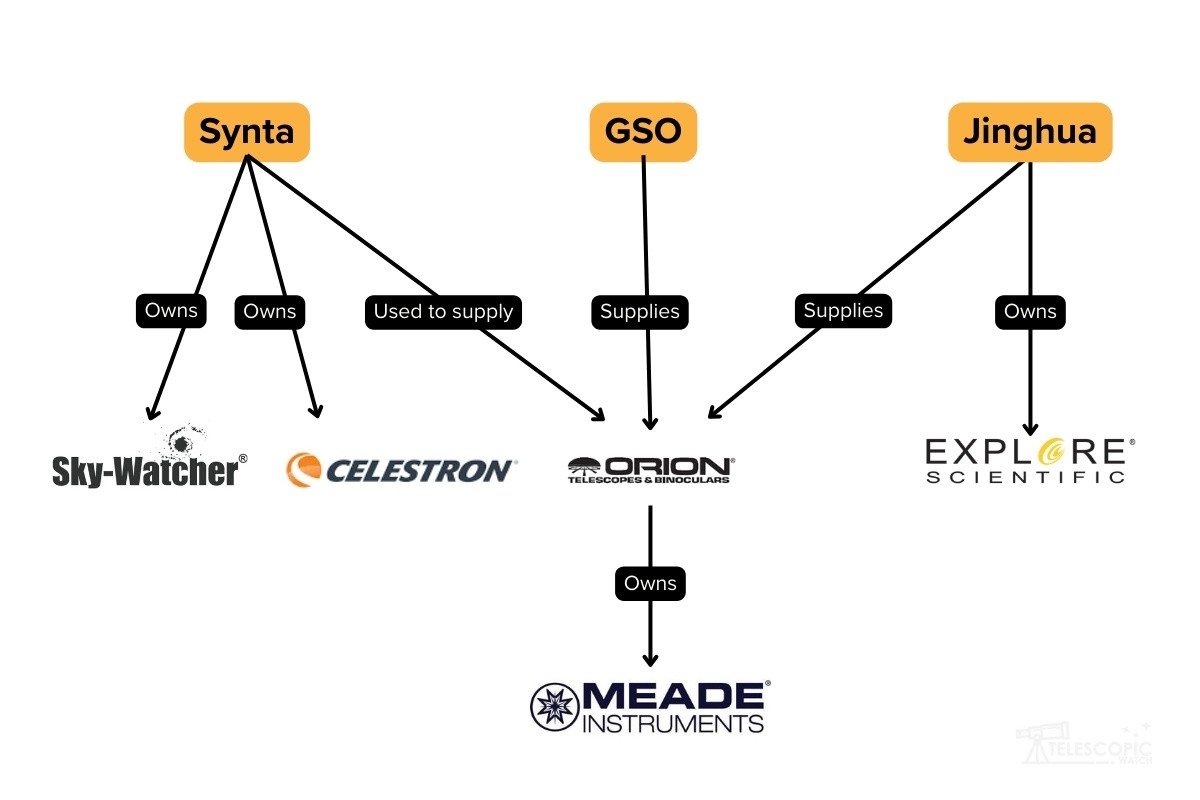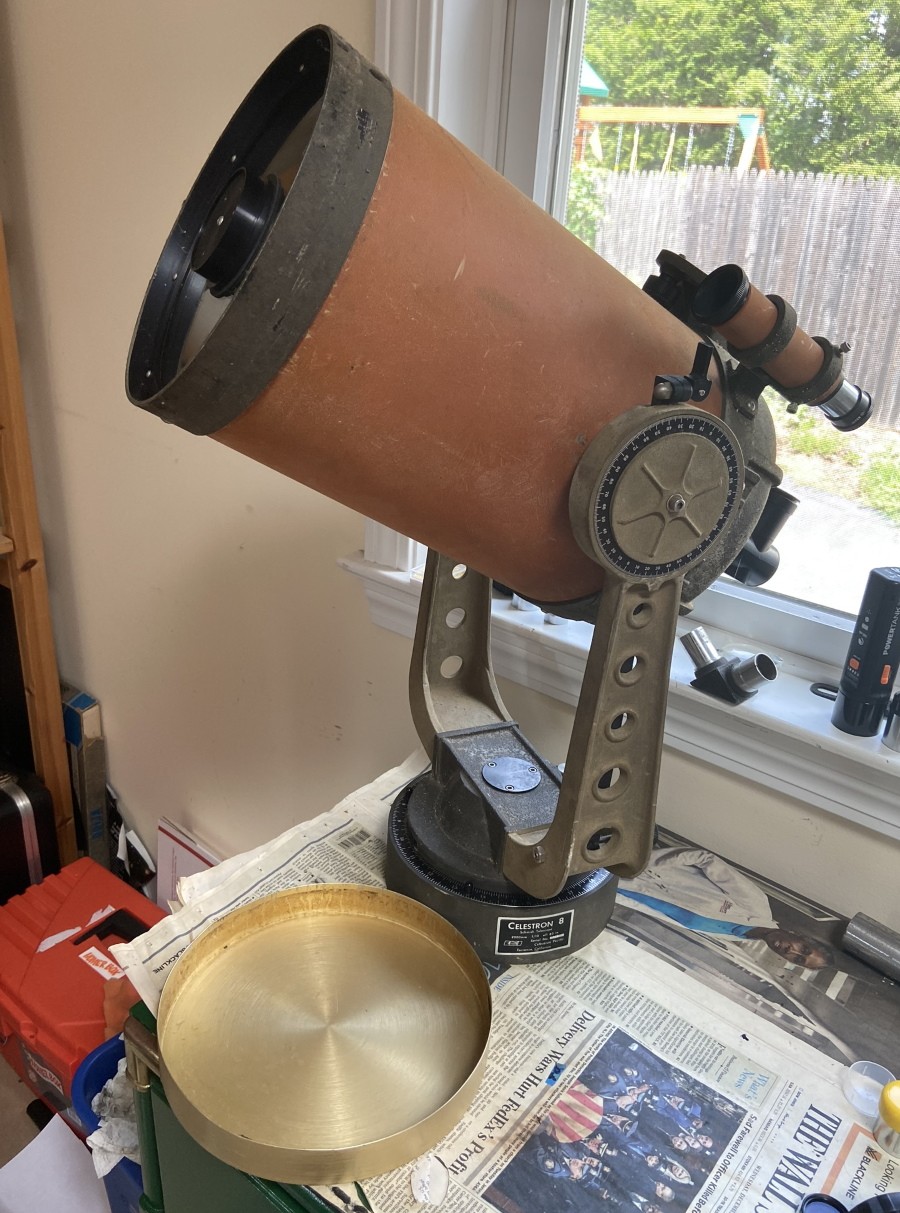I started off my astronomy hobby by buying a highly hyped telescope, the NexStar 4SE, from one of the most well-known brands in the US, Celestron. Likewise, a lot of people really buy into brands.
Brands have reputations, which they (theoretically) also have to defend by providing quality products and services. Unfortunately, when it comes to choosing a telescope, even the idea of a brand at all is kind of an illusion to begin with.
What even are these “brands” anyway?
Today, a handful of factories owned by conglomerates in Asia—primarily China and Taiwan, but also a few in Japan and other nations—manufacture almost all telescopes and astronomical equipment sold today.

Ever since telescopes began to be imported from Japan into the West in the 1950s, there have been competing “brands” selling what is often literally the same gear or simply repackaged or with different included accessories.
In the 1970s and 1980s, Celestron, Meade, and other major manufacturers began buying equipment from the renowned Japanese manufacturers Vixen and Mizar, among others, and then sticking their brand name on it.
In the 1990s, telescopes from the financially ailing Russian Federation and new entrants from both mainland China and the island of Taiwan began to seep into the product lines of telescope manufacturers like Celestron, Meade, Orion, etc.
With the sole exception of Orion, at one point or another, these companies all became partially or fully owned by their former Chinese OEMs.
Until 2020, Orion was selling a hodgepodge of equipment made by Synta, Vixen, various Taiwanese manufacturers, and occasionally even some stuff from Russia. They made none of their merchandise in-house and basically never had done so in their history, with a few small exceptions. Orion finally ended up shutting their shop permanently in mid-2024.
Most of the telescope and astronomical equipment “brands” today are in one of the following business arrangements, of which I’ll give examples:
Large Asian corporations with some sort of domestic subsidiary or partner in the US/EU—most brands you are aware of are probably directly under or involved with one of these
- Synta (Celestron/Sky-Watcher) is perhaps the biggest of these
- Guan Sheng Optical (Apertura AD Dobs, manufactures Zhumells under extremely unusual subsidiary arrangement of sorts with Synta)
- Jinghua Optical Co. (Explore Scientific/Bresser, OEM for NatGeo)
- Long Perng (OEM for a lot of brands)
- Bosma (OEM for iOptron, others)
Drop-shippers or attempts by manufacturers in China/Taiwan to undercut American/European import companies and sell directly to consumers wholesale
- Cameras and more photography-oriented stuff like ZWO, Player One, Optolong
- Long Perng has been doing this more (Founder Optics etc)
- SVBONY
- Sarblue
- Gskyer
- “Maxvision” (JOC)
- Skyoptiskt
Smaller businesses that manufacture equipment in-house or import specifically designed/semi-exclusive equipment and deal directly or semi-directly with consumers
- APM (higher-end products in-house; eyepieces are made by Long Perng and others)
- Stellarvue
- Starizona
- Takahashi
These are just examples, but I’ve highlighted some of the biggest and most well-known brands in history.
Not all telescopes/accessories offered by a given brand are created equal
One thing you might have picked up on—and should—is that many of the larger telescope manufacturers have brand subsidiaries that compete with each other, or at least pretend to. Does that mean that the global telescope market is basically an oligopoly or is on the verge of being one? Many people have claimed such a scenario to be the case.
Given the complex nature of the relationships many Chinese companies have with each other and the Chinese government, it’s actually hard to tell whether many newer small brands are just salesmen for the old guard or are genuinely new and unrelated facilities and organizations.
In any case, given that U.S. and European organizations like the FTC have little insight or actual legal power over the situation with the established players, I chose not to worry about it too much.
The Varying Quality of Celestron and Sky-Watcher Products
Celestron and Sky-Watcher are probably the best examples of two subsidiaries of the same company (Synta) competing with each other.
If you’re familiar with some of the equipment these brands offer, you might liken it to the auto manufacturer Ford and their luxury car division, Lincoln.
At first glance, it looks kind of like Celestron makes for the most part, lower-quality gear catered to lower budgets than the more expensive, high-quality equipment Sky-Watcher sells. But both offer plenty of good and bad products at a variety of price points.
There is not a ton of overlap between Celestron’s and Sky-Watcher’s offerings. For example, Celestron has no GoTo Dobs or apochromatic refractors, which are the bread and butter of Sky-Watcher’s offerings in North America.
However, if you dig a bit deeper, you’ll realize that both brands do offer products that are direct competitors and superior to some of each other’s competing offerings at basically the same price point.
For instance, the Celestron CGEM II is a vastly inferior mount for astrophotography and, in general, compared to the Sky-Watcher EQ6Ri Pro but they retail for around the same price and offer the same form factor and payload capacity. The same is the case with their smaller counterparts, the Celestron Advanced VX and Sky-Watcher HEQ5. How could it make sense to keep two production lines open?
Celestron is beloved by older astronomers, particularly the Baby Boomer generation. Only Meade Instruments—now a mere shell of its former self—comes close in terms of the cult-like following Celestron has. For decades, Celestron has made some really great strides in the fields of telescope optics and electronics/software for equatorial mounts. Celestron and their owners at Synta know this.

They also know that if you go to a star party and look through a high-quality Celestron telescope, you’re more likely to just associate the brand with the nice views rather than the particular product (if you can even remember what that was).
The Celestron situation is a little more complex than some, but the more basic principles I just mentioned apply to every brand.
The Varying Quality Explore Scientific Products
Explore Scientific/Bresser is similar. Most of their product range is outstanding, but their tripod-mounted telescopes marketed towards beginners, such as the FirstLight line, either miss the mark in terms of design/features and price or are completely unusable.
The bottom line? Shop based on the virtues of an individual telescope/accessory and ignore the brand. Hardware like dovetails, eyepieces, filters, finder scopes, etc. is largely universal and interchangeable if you’re worried about that.

Thanks for having such a useful website about Telescope. I am new to this and looking to buy my 1st telescope. Budget is AUD $500 or less which is USD $325. Depending on the Telescope, I won’t mind paying up to AUD ~$50 more.
From your articles, it seems that Dobsonion Telescopes are best and easiest for beginners. However, it also seems that 6″ Dobsonion is not that good (except Apertura AD6). From their specifications, it seems that they are very bulky too. So not sure how easy for me to take it out to Backyard or somewhere else in car and put it back. I understand that they take less space when not in use. Tabletop Dobsonion are compact but then if I take that out, I will need proper stand or thing to put it so I can use and observe planets etc. From reviews, it seems 8″ Dobsonion would be the best (if not bulky) but then they are way out of my budget. The one I can try to afford is Saxon (https://www.sirius-optics.com.au/saxon-6-inch-deepsky-dobsonian-telescope.html) and Sky-Watcher (https://www.ozscopes.com.au/skywatcher-6-dobsonian-telescope.html). I will need to have a look if they are not bulky and heavy. But are they good? Especially as they are only 6″. I didn’t see any review on your site abt them as they may not be popular in USA. Especially Saxon may not be even sold.
From Refractor Telescope, it seems StarSense 100 DX is good but looks like it is no longer sold. There are few which are available on Amazon or Ebay and these stores also of 90mm. But I cannot find any review of them. Are they good?
SVBony seems to have one in my budget but that is only 80mm. I think 80mm would not be of any use at all.
Can you pls suggest the ones I mentioned if they are good or not? Or any 90mm Telescope? Also, if Reflector Telescopes are good? Like 130mm EQ? Thanks.
Thanks for having such a useful website about Telescope. I am new to this and looking to buy my 1st telescope. Budget is AUD $500 or less which is USD $325. Depending on the Telescope, I won’t mind paying up to AUD ~$50 more.
From your articles, it seems that Dobsonion Telescopes are best and easiest for beginners. However, it also seems that 6″ Dobsonion is not that good (except Apertura AD6). From their specifications, it seems that they are very bulky too. So not sure how easy for me to take it out to Backyard or somewhere else in car and put it back. I understand that they take less space when not in use. Tabletop Dobsonion are compact but then if I take that out, I will need proper stand or thing to put it so I can use and observe planets etc. From reviews, it seems 8″ Dobsonion would be the best (if not bulky) but then they are way out of my budget. The one I can try to afford is Saxon (https://www.sirius-optics.com.au/saxon-6-inch-deepsky-dobsonian-telescope.html) and Sky-Watcher (https://www.ozscopes.com.au/skywatcher-6-dobsonian-telescope.html). I will need to have a look if they are not bulky and heavy. But are they good? Especially as they are only 6″. I didn’t see any review on your site abt them as they may not be popular in USA. Especially Saxon may not be even sold.
From Refractor Telescope, it seems StarSense 100 DX is good but looks like it is no longer sold. There are few which are available on Amazon or Ebay and these stores also of 90mm. But I cannot find any review of them. Are they good?
SVBony seems to have one in my budget but that is only 80mm. I think 80mm would not be of any use at all.
Can you pls suggest the ones I mentioned if they are good or not? Or any 90mm Telescope? Also, if Reflector Telescopes are good? Like 130mm EQ?
Please suggest if 90mm is good or that is also not too good. Or any reflector telescope if that is good? Thanks.